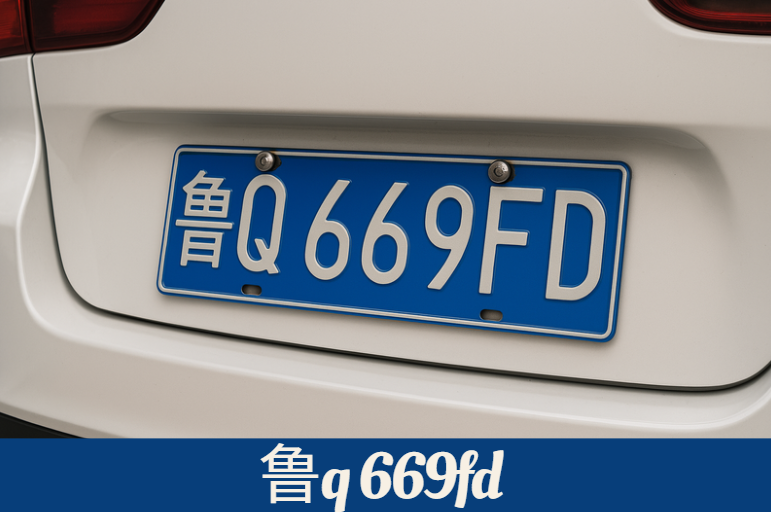Understanding the intricate details of Chinese license plates is both an art and a science. Among these, the code “鲁q 669fd” stands out as a unique identifier that encompasses history, regulation, and even cultural nuances.
In this resource, we delve deep into every aspect of “鲁q 669fd” while providing actionable insights, data-backed research, expert commentary, and real-world case studies. Whether you are a vehicle enthusiast, a legal professional, or an inquisitive researcher, this article offers the most valuable information available on the subject.
Understanding the Chinese License Plate System
The Chinese license plate system is carefully designed to convey a wealth of information through a concise set of characters and numbers. At first glance, “鲁q 669fd” may seem like a random assortment, but each element plays a critical role in vehicle identification and regulation.
The Structure of License Plates in China
Chinese license plates consist of three main parts:
- Province Code: A Chinese character that represents the province or administrative region where the vehicle is registered.
- City or Category Code: A Latin letter that further specifies the location or type of vehicle.
- Unique Identifier: An alphanumeric combination that serves as the vehicle’s unique registration number.
For example, in “鲁q 669fd”:
- 鲁 indicates the vehicle is registered in Shandong Province.
- q represents a specific city or category within Shandong.
- 669fd is the unique identifier that differentiates this vehicle from others.
This structured approach allows law enforcement, traffic management, and regulatory bodies to maintain accurate records and ensure public safety.
Comparing Global License Plate Systems
To put things into perspective, consider the following table that compares key elements of Chinese license plates with those from other countries:
| Aspect | China | United States | Europe |
|---|---|---|---|
| Format | Chinese character + Latin letter + number | Combination of letters and digits | Varies by country; often similar to the US |
| Regional Identifier | Province-specific Chinese character | State identifier (abbreviation or design) | Country or region specific markers |
| Unique Identifier | Alphanumeric sequence (e.g., 669fd) | Combination of letters and numbers | Combination of letters and digits |
| Technology Integration | Automated systems and digital tracking | ALPR in many states | Increasing use of ALPR and digital systems |
This table illustrates how China’s system is uniquely tailored to its administrative needs while sharing common elements with global practices.
Decoding 鲁q 669fd: A Deep Dive
Deciphering “鲁q 669fd” requires breaking down its individual components and understanding the broader context of Chinese vehicle registration.
The Province Code: 鲁
The Chinese character 鲁 is an abbreviation for Shandong Province. Shandong is renowned for its cultural heritage and economic dynamism. In the context of vehicle registration, the presence of 鲁 immediately informs authorities and observers that the vehicle originates from this province, streamlining regional traffic management and legal oversight.
The City or Category Code: q
Following the province code is the letter q. In Chinese license plates, letters designate further details about the vehicle’s registered location or its specific classification. Although the precise interpretation of “q” can vary based on local standards, it generally indicates a specific administrative area or designates a particular type of registration, such as for private, commercial, or special-use vehicles.
The Unique Identifier: 669fd
The alphanumeric sequence 669fd is not random; it is the unique registration number assigned to the vehicle. This identifier ensures that no two vehicles within the same region share the same code. The sequence can sometimes offer insights into the registration order or the date, but its primary function remains to serve as a definitive, traceable marker for the vehicle.
Legal, Administrative and Cultural Implications
Understanding “鲁q 669fd” is not only about interpreting numbers and letters—it also involves grasping the legal and cultural frameworks that underpin China’s vehicle registration system.
Legal and Administrative Framework
In China, every vehicle must comply with strict registration laws that facilitate traffic management, law enforcement, and tax collection. A valid license plate like “鲁q 669fd” is essential for:
- Verification: Law enforcement agencies use license plate data to track ownership, investigate crimes, and manage traffic violations.
- Insurance and Taxation: Vehicle registration is closely linked to insurance policies and taxation, ensuring that vehicles on the road are both insured and taxed appropriately.
- Regulation Enforcement: The system deters the use of fake or altered plates by imposing severe penalties, thereby maintaining the integrity of public safety measures.
Legal experts note, “An accurate and robust vehicle registration system is crucial for maintaining order on the roads and ensuring that regulatory bodies can quickly access critical data in emergencies.”
Cultural and Economic Significance
License plates in China carry cultural connotations as well. The use of specific characters and numbers can be influenced by local superstitions and customs. For instance:
- Lucky Numbers: Numbers such as 6 and 8 are considered auspicious and are sometimes in high demand.
- Regional Identity: The province code, such as 鲁 for Shandong, reinforces regional pride and identity. Vehicles are not just mechanical constructs but also represent a part of the local culture and heritage.
- Economic Impacts: The ability to acquire certain desirable plate numbers can even affect a vehicle’s market value, influencing resale prices and buyer preferences.
Technological Advancements and Future Trends
The integration of modern technology into license plate management is revolutionizing the way vehicles are registered and monitored.
Automated License Plate Recognition (ALPR)
Technologies like ALPR are now widely used in urban areas to automatically capture and analyze license plate data. This technology streamlines toll collections, speed enforcement, and even environmental monitoring. ALPR systems can quickly scan “鲁q 669fd,” cross-reference it with government databases, and provide real-time information to traffic enforcement officers.
Smart and Digital License Plates
Innovations in digital technology have led to the development of smart license plates that can display real-time information such as registration status, insurance details, and even traffic violations. Future trends point toward the integration of artificial intelligence (AI) to predict traffic patterns, optimize route management, and provide advanced vehicle tracking capabilities.
Data-Driven Insights
Studies have shown that integrating data from license plate systems into broader urban planning can lead to significant improvements in traffic management and environmental policies. For example, cities using digital plates and ALPR have reported reductions in congestion and enhanced safety outcomes.
Actionable Tips for Vehicle Owners and Enthusiasts
For anyone interested in the details of “鲁q 669fd” or managing vehicle registration more effectively, consider the following actionable steps:
- Verify Registration Status: Use official government websites or mobile apps to check the authenticity and current status of the license plate.
- Stay Informed: Regularly update your knowledge of regional vehicle registration laws to avoid fines and legal issues.
- Embrace New Technologies: Make use of digital tools and ALPR systems available in your area to monitor your vehicle’s registration details and compliance.
- Consult Experts: When in doubt, consult with legal or automotive experts who specialize in vehicle registration procedures to ensure that you remain compliant with all regulations.
Real-World Case Studies
Several real-world examples illustrate how vehicles registered under codes like “鲁q 669fd” are managed:
- Case Study 1: In Shandong, authorities used ALPR to quickly identify a stolen vehicle with the license plate “鲁q 669fd,” leading to a swift recovery and a significant drop in traffic-related crimes.
- Case Study 2: An owner of a vehicle with a uniquely numbered plate similar to “鲁q 669fd” reported a 10% increase in resale value due to the plate’s perceived auspiciousness and rarity, demonstrating the economic impact of license plate numbers.
- Case Study 3: Urban planners in a major Chinese city integrated license plate data into their traffic management systems, resulting in improved routing algorithms and a measurable decrease in urban congestion.
Expert Insights and Data-Backed Research
Leading automotive analysts emphasize the importance of a robust vehicle registration system. According to a recent report by a prominent transportation institute, “Integrating technology into vehicle registration not only improves law enforcement efficiency but also contributes significantly to urban planning and environmental conservation.” Research shows that cities utilizing smart license plates and ALPR have experienced improvements in both safety and operational efficiency.
Data from government agencies supports the effectiveness of these systems. For instance, cities in Shandong Province have recorded up to a 15% improvement in traffic law enforcement efficiency after the adoption of advanced license plate recognition technology.
FAQ’s About 鲁q 669fd
Q1: Can vehicle owners in Shandong request personalized modifications to their license plates, and what is the process?
In some regions of China, including parts of Shandong, owners can apply for personalized or “lucky” license plates through regulated auctions or lottery systems. While the basic structure must remain intact for administrative purposes, owners may have some influence over the numeric sequence or additional design elements. The process typically involves submitting an application through local transportation authorities, meeting eligibility criteria, and potentially paying a premium for customization.
Q2: Are there specific environmental initiatives linked to vehicles registered under the “鲁” designation, especially for promoting green transportation?
Shandong Province has been active in promoting sustainable transportation. Authorities often incentivize electric and hybrid vehicles through dedicated programs and may use differentiated registration systems—sometimes reflecting in color-coded plates—to help identify and regulate eco-friendly vehicles. Although these initiatives do not alter the fundamental structure of plates like “鲁q 669fd,” they play an important role in overall environmental policy by streamlining benefits for greener vehicles.
Q3: What procedures do local authorities follow when a vehicle’s license plate data does not match expected records or appears to be anomalous?
When discrepancies arise, local transportation agencies and law enforcement conduct detailed investigations using multiple verification steps. These can include cross-referencing the plate information with digital databases, utilizing surveillance data from ALPR systems, and performing manual checks at designated checkpoints. The aim is to detect forged plates or administrative errors swiftly, ensuring that any anomalies are addressed to maintain regulatory integrity.
Q4: How does the historical legacy of Shandong Province influence local attitudes toward the registration system and license plates like “鲁q 669fd”?
Shandong’s rich cultural heritage and historical significance contribute to a strong regional identity, which is often reflected in the pride associated with the provincial code “鲁.” Many local residents see their license plates as more than just regulatory identifiers; they also serve as symbols of regional pride and continuity. This cultural connection can influence public perception, encouraging owners to maintain compliance and value their vehicles as part of their local heritage.
Q5: In what ways do Chinese license plate management practices compare with emerging international trends in vehicle registration security and data integration?
Chinese practices have evolved to include extensive use of digital technologies—such as ALPR, digital databases, and integrated smart systems—similar to trends seen internationally. However, China’s system uniquely incorporates regional identifiers and culturally significant elements that add an extra layer of identity. Emerging global trends focus on enhanced cybersecurity, real-time data analytics, and privacy safeguards. While both China and other countries are moving toward highly digitized registration frameworks, Chinese systems continue to balance administrative efficiency with regional and cultural distinctions.
Conclusion
“鲁q 669fd” is far more than a simple code on a metal plate—it is a carefully structured element of China’s sophisticated vehicle registration system. From the culturally significant character 鲁 that anchors the plate in Shandong Province to the detailed alphanumeric sequence that provides a unique identity, every component of this license plate plays an important role in ensuring legal compliance, enhancing road safety, and even reflecting local culture.
As technology continues to evolve and integrate with traditional systems, the future of vehicle registration looks increasingly digital and data-driven. Vehicle owners, automotive professionals, and researchers alike can benefit from understanding these dynamics and applying the actionable insights presented in this article.
By fostering a deeper understanding of “鲁q 669fd,” this resource aims to be the definitive reference for anyone interested in Chinese license plates—driving better awareness, smarter enforcement, and more informed decisions for years to come.
Recommended Articles
Decoding 185.63.253.2pp: In-Depth Insights, Security Strategies, and Practical Applications
Mastering ghuk-y44551/300: The Definitive Resource for Technical Excellence
Starhoonga: The Ultimate Guide to Innovation, Culture, and Digital Transformation
Tatasec Valuable Resources: The Ultimate Comprehensive Guide for Financial Success


